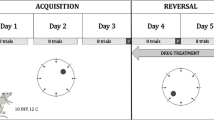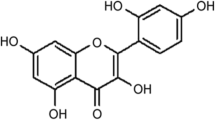Abstract
High doses of NMDA antagonists e.g. (+)MK-801 evoke neurodegeneration in retrosplenial cortex in rodents. To assess functional consequences of such treatment, three paradigms of two-way active avoidance learning (with visual or auditory conditioned stimuli) and additionally a spatial learning paradigm — radial maze — were used. Female rats were treated i.p. with 5 mg/kg of (+)MK-801. Recumbence, severe hypothermia and loss of body weight were observed for 3–7 days. Despite that, there were no statistically significant differences in performance of avoidance reaction between saline and (+)MK-801 treated animals trained 10–40 days after the drug administration. However, in the radial maze test (+)MK-801 impaired reference (but not working) memory in the experiment that started 8 days after the treatment. Similar effect was observed on reversal learning. The clinically used NMDA receptor antagonist memantine at the doses of 20 and 40 mg/kg had also no such long term negative effect on working memory during training (even positive effect was seen at 20 mg/kg) but at 40 mg/kg impaired learning on the first day of reversal. This indicates that (+)MK-801 neurotoxicity in the retrosplenial cortex is connected with subtle alterations in the learning performance that may be seen in some tests only. Moreover, memantine doses greatly exceeding therapeutically relevant range produce minimal functional alteration. An additional experiment revealed that the same dose of memantine results in two fold higher serum levels of the antagonist in female than male rats. Hence, considering that profiling studies are done in male rats, a safety factor of over 16 fold can be calculated for memantine.
Similar content being viewed by others
Reference
Auer, R.N. (1996) Effect of age and sex on N-methyl-D-aspartate antagonist-induced neuronal necrosis in rats. Stroke27, 743–746.
Auer, R.N. and Coulter, K.C. (1994) The nature and time course of neuronal vacuolation induced by the N-methyl-D-aspartate antagonist MK-801. Acta Neuropathol.87, 1–7.
Auer, R.N., Coupland, S.G., Jason, G.W., Archer, D.P., Payne, J., Belzberg, A.J., Ohtaki, M. and Tranmer, B.I. (1996) Postischemic therapy with MK-801 (dizocilpine) in a primate model of transient focal brain ischemia. Mol. Chem. Neuropathol.29, 193–210.
Brosnan Watters, G., Wozniak, D.F., Nardi, A. and Olney, J.W. (1999) Parallel recovery of MK-801-induced spatial learning impairment and neuronal injury in male mice. Pharmacol. Biochem. Behav.62, 111–122.
Chen, H.S.V., Wang, Y.F., Rayudu, P.V., Edgecomb, P., Neill, J.C., Segal, M.M., Lipton, S.A. and Jensen, RE. (1998) Neuroprotective concentrations of the N-methyl-D-aspar-tate open-channel blocker memantine are effective without cytoplasmic vacuolation following post-ischemic administration and do not block maze learning or long-term potentiation. Neuroscience86, 1121–1132.
Corbett, D., Evans, S., Thomas, C, Wang, D. and Jonas, R.A. (1990) MK-801 reduced cerebral ischemic injury by inducing hypothermia. Brain Res.514, 300–304.
Danysz, W., Parsons, C.G., Bresink, I. and Quack, G. (1995) Glutamate in CNS disorders — A revived target for drug development. Drug News Perspect.8, 261–277.
Danysz, W., Parsons, C.G., Kornhuber, J., Schmidt, W.J. and Quack, G. (1997) Aminoadamantanes as NMDA receptor antagonists and antiparkinsonian agents — preclinical studies. Neurosci. Biobehav. Rev.21, 455–468.
Fix, A.S., Long, G.G., Wozniak, D.F. and Olney, J.W. (1994) Pathomorphologic effects of N-methyl-D-aspartate antagonists in the rat posterior cingulate/retrosplenial cerebral cortex: a review. Drug Dev. Res.32, 147–152.
Fix, A.S., Wozniak, D.F., Truex, L.L., McEwen, M., Miller, J.P. and Olney, J.W. (1995) Quantitative analysis of factors influencing neuronal necrosis induced by MK-801 in the rat posterior cingulate retrosplenial cortex. Brain Res.696, 194–204.
Gabriel, M., Sparenborg, S. and Stolar, N. (1987) Hippocampal control of cingulate cortical and anterior thalamic information processing during learning in rabbits. Exp. Brain Res.67, 131–152.
Hesselink, M.B., De Boer, A.G., Breimer, D.D. and Danysz, W. (1999) Brain penetration and in vivo recovery of NMDA receptor antagonists amantadine and memantine: a quantitative microdialysis study. Pharmaceut. Res.16, 637–642.
Hetman, M., Danysz, W. and Kaczmarek, L. (1997) Increased expression of cathepsin D in retrosplenial cortex of MK-801treated rats. Exp. Neurol.147, 229–237.
Huber, K.R., Sahota, P.S., Kapeghian, J., Han Hsu, H., Amemiya, K., Arthur, A.T., Tripp, S.L. and Traina, V.M. (1997) Lack of neuronal vacuolation and necrosis in monkeys treated with selfotel (CGS 19755), a competitive N-methyl-D-aspartate receptor antagonists. Int. J. Toxicol.16, 175–181.
Lipton, S.A. (1993) Prospects for clinically tolerated NMDA antagonists-open-channel blockers and alternative redox states of nitric oxide. Trends Neurosci.16, 527–532.
Marston, H.M., West, H.L., Wilkinson, L.S., Everitt, B.J. and Robbins, T.W. (1994) Effects of excitotoxic lesions of the septum and vertical limb nucleus of the diagonal band of Broca on conditional visual discrimination: relationship between performance and choline acetyltransferase activity in the cingulate cortex. J. Neurosci.14, 2009–2019.
Nietosampedro, M., Bailon, C, Rivas, F. and Moreno, M.T. (1991) Sex differences in the effect of MK-801 on normal and spinal cord injured rats. Restor. Neurol. Neurosci.2, 175–179.
Nikolaev, E. and Kaczmarek, L. (1994) Disruption of two-way active avoidance behavior produced by nimodypine. Pharmacol. Biochem. Behav.47, 757–759.
Olney, J.W., Labruyere, J. and Price, M.T. (1989) Pathological changes induced in cerebrocortical neurons by phencyclidine and related drugs. Science244, 1360–1362.
Olney, J.W., Labruyere, J., Wang, G., Wozniak, D.F, Price, M.T. and Sesma, M.A. (1991) NMDA antagonist neurotoxicity — mechanism and prevention. Science254, 1515–1518.
Parsons, C.G., Danysz, W. and Quack, G. (1999) Memantine is a clinically well tolerated NMDA receptor antagonist — a review of preclinical data. Neuropharmacology38, 735–767.
Rogers, B.C. and Tilson, H.A. (1990) Kainate-induced functional deficits are not blocked by MK-801. Neurosci. Lett.109, 335–340.
Trafton, C.L. (1967) Effects of lesions in the septal area and cingulate cortical areas on conditioned suppression of activity and avoidance behavior in rats. J. Comparative Physiological Psychology63, 191–197.
Vogt, B.A., Finch, D.M. and Olson, C.R. (1992) Functional heterogeneity in the cingulate cortex: the anterior executive and posterior evaluative regions. Cer. Cortex2, 435–443.
Wintrip, N., Nance, D.M. and Wilkinson, M. (1998) Sexually dimorphic MK801-induced c-fos in the rat hypothalamic paraventricular nucleus. Neurosci. Lett.242, 151–154.
Wozniak, D.F., Brosnanwatters, G., Nardi, A., Mcewen, M., Corso, T.D., Olney, J.W. and Fix, A.S. (1996) MK-801 neurotoxicity in male mice: histologic effects and chronic impairment in spatial learning. Brain Res.707, 165–179.
Zielinski, K., Werka, T. and Nikolaev, E. (1991) Intertrial responses of rats in two-way avoidance learning to visual and auditory stimuli. Acta Neurobiol. Exp.51, 71–88.
Zielinski, K., Werka, T, Wilson, W.J. and Nikolaev, E. (1995) Inhibition of delay of the two-way avoidance response and warning-signal salience. Anim. Learn. Behav.23, 438–446.
Zilles, K. and Wree, A. (1985) Cortex: areal and laminar structure. In Paxinos, G. (Ed.), The Rat Nervous System, Vol. 1 (North Ryde: Academic Press), pp. 375–415.
Author information
Authors and Affiliations
Corresponding author
Rights and permissions
About this article
Cite this article
Zajaczkowski, W., Hetman, M., Nikolaev, E. et al. Behavioural evaluation of long-term neurotoxic effects of NMDA receptor antagonists. neurotox res 1, 299–310 (1999). https://doi.org/10.1007/BF03033259
Received:
Revised:
Issue Date:
DOI: https://doi.org/10.1007/BF03033259




